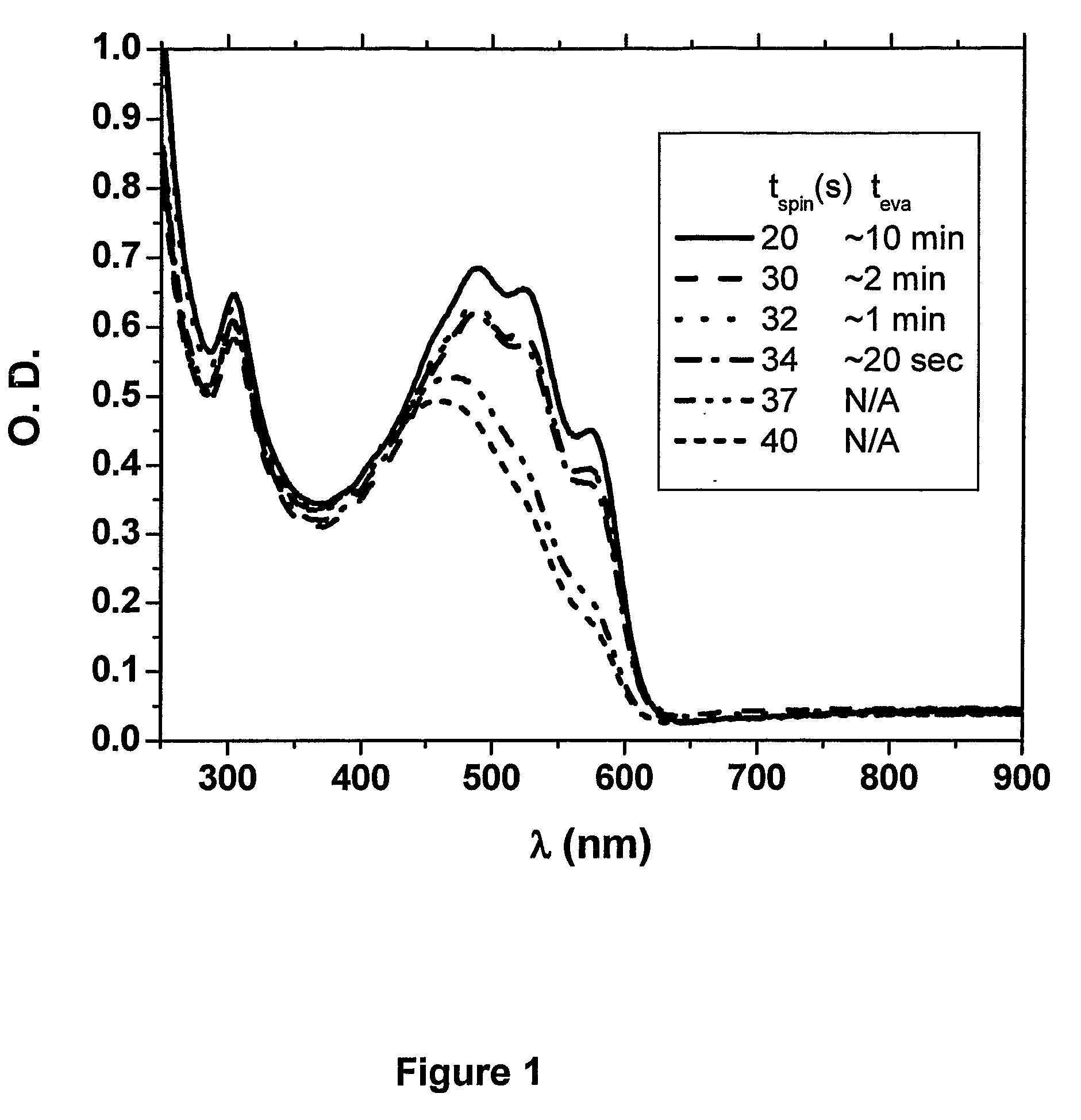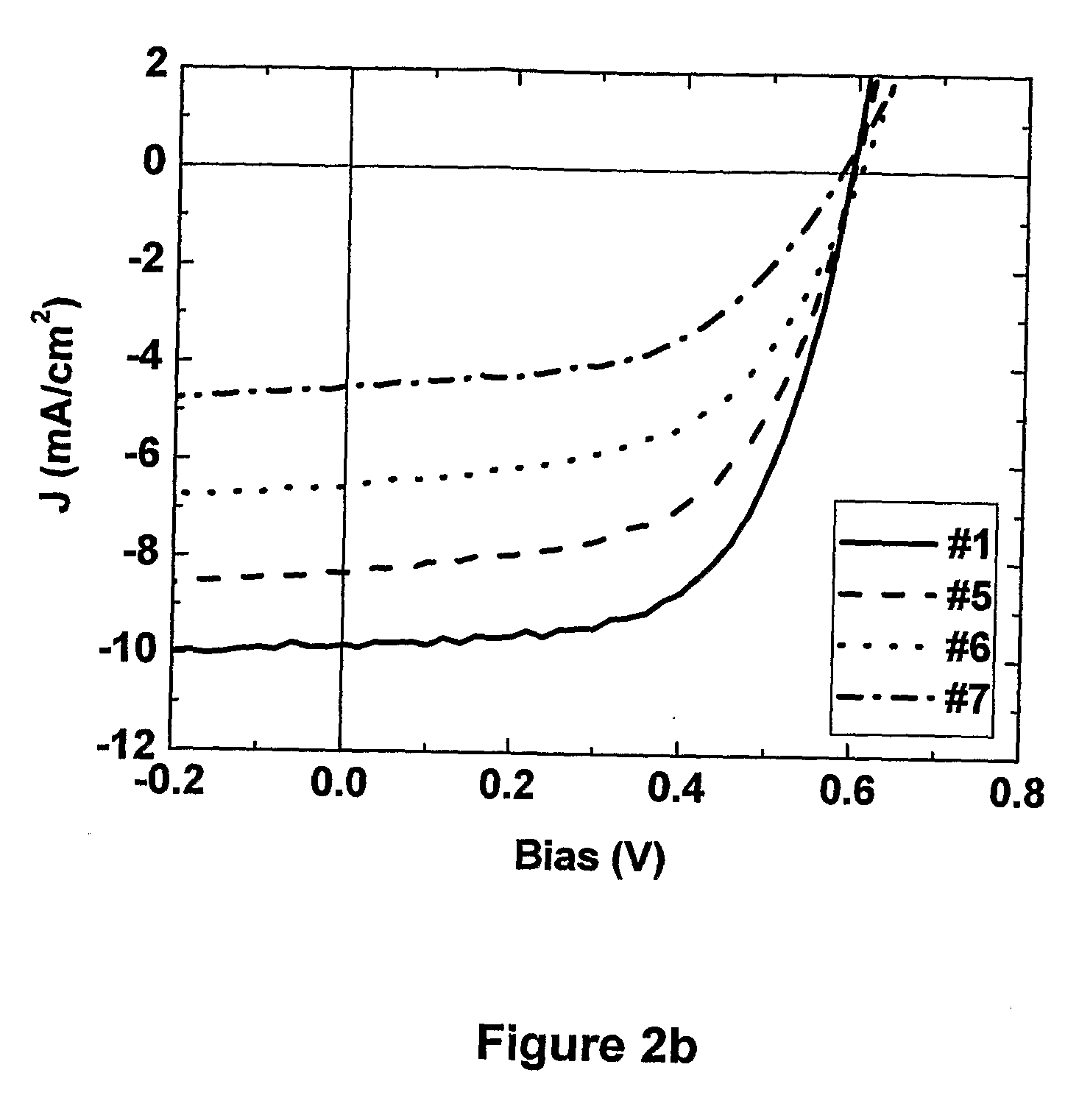Highly Efficient Polymer Solar Cell by Polymer Self-Organization
a solar cell, self-organization technology, applied in the direction of nanoinformatics, sustainable manufacturing/processing, final product manufacturing, etc., can solve the problems of low efficiency (3-4%) of plastic solar cells, limit their commercial use feasibility, etc., and achieve the effect of better materials
- Summary
- Abstract
- Description
- Claims
- Application Information
AI Technical Summary
Benefits of technology
Problems solved by technology
Method used
Image
Examples
example 1
[0036]A polymer photovoltaic cell according to an embodiment of this invention has a polymer:fullerene blend for an active layer sandwiched betveen a transparent anode on glass (polyethylenedioxythiophene:polystyrenesulfonate (PEDOT:PSS) modified indium tin oxide) and a metal cathode (Ca (25 nm) capped with Al (100 nm) to protect from oxidation). A blend of regioregular poly(3-hexylthiophene) (RR-P3HT) and methanofullerene (PCBM) in 1:1 wt-ratio was used as the active layer in this example. Before device fabrication, the ITO (˜150 nm)-coated glass substrates were cleaned by ultrasonic treatment in detergent, de-ionized water, acetone and isopropyl alcohol, sequentially. A thin layer (˜30 nm) of PEDOT:PSS (Baytron P VP Al 4083) was spin-coated to modify the ITO surface. After baking at 120° C. for I hour, the substrates were transferred inside a nitrogen filled glove box (2 & H2O) . P3HT was first dissolved in 1,2-dichlorobenzene (DCB) to make 17 mg / ml solution, followed by blending ...
example 2
[0043]In this example 20 ml / mg P3HT and 20 mg / ml PCBM in 1,2-dichlorobenzene (DCB) (m.p. -17° C., bp 180° C.) solution was used. A spin speed of 600 rpm for 60 seconds was used and a slow growth film of ˜210 nm was achieved. The power conversion efficiency (PCE) under standard AM1.5 G 1-sun testing condition was found to be up to about 4.4%.
example 3
[0044]In this example the same solution as Example 2 is used, but a spin speed of 3000 rpm is used. This reduces the spin-coating time tsto 5-10 seconds. Slow growth film devices with ˜70 nm were achieved. AM1.5 G PCE of 3.0% was achieved in a ts=5 sec device (film grown time ˜10 min) with fill-factor of 69.2%. The ts=10 sec device has film grown time of ˜2 min and PCE of 2.8% (FF 66%). Reduced film growth time might be advantageous for some applications. Spin coating over 20 seconds at 3 k rpm can eliminate slow growth pattern.
PUM
| Property | Measurement | Unit |
|---|---|---|
| Power conversion efficiency | aaaaa | aaaaa |
| Fraction | aaaaa | aaaaa |
| Fraction | aaaaa | aaaaa |
Abstract
Description
Claims
Application Information
 Login to View More
Login to View More - R&D
- Intellectual Property
- Life Sciences
- Materials
- Tech Scout
- Unparalleled Data Quality
- Higher Quality Content
- 60% Fewer Hallucinations
Browse by: Latest US Patents, China's latest patents, Technical Efficacy Thesaurus, Application Domain, Technology Topic, Popular Technical Reports.
© 2025 PatSnap. All rights reserved.Legal|Privacy policy|Modern Slavery Act Transparency Statement|Sitemap|About US| Contact US: help@patsnap.com



